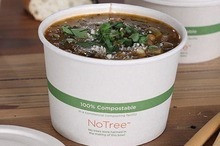Bowls
Our compostable bowls come in a wide variety of materials, sizes and shapes. Most are also certified compostable to break down into soil in 2-5 months. Shop our selection of eco-friendly bowls and lids! Free Samples, Wholesale Pricing & FREE Shipping +$50!
Compostable Bowls FAQs
What are compostable bowls made of, and how do they differ from regular paper bowls?
Compostable bowls are typically crafted from renewable plant fibers, such as sugarcane bagasse, NoTree Paper made from bamboo fiber or PLA, a plant-based bioplastic. All of these materials are designed to break down naturally in composting conditions. Unlike standard paper bowls, which may contain plastic coatings or wax that inhibit decomposition, compostable bowls meet specific standards (e.g., ASTM D6400/D6868 or certifications from BPI, CMA, or TÜV Austria) to ensure they break down cleanly without leaving harmful residue.
Are compostable bowls microwave safe?
Compostable bowls made from sugarcane bagasse, or similar plant fibers, are microwave safe for short durations. Bowls made with PLA are not microwavable and would soften or warp under prolonged high heat.
What certifications should I look for to ensure bowls are truly compostable?
To confirm authentic compostability, look for third-party certifications such as BPI, CMA, TÜV Austria (OK Compost), or compliance with ASTM D6400/D6868 standards. These certifications ensure products decompose effectively in industrial composting facilities.
Can compostable bowls be composted at home or only in industrial facilities?
Most compostable bowls are designed for industrial composting, which provides the high heat and controlled conditions needed for breakdown. Only some fiber products are certified for home composting (look for labels like OK Compost HOME). If you lack local composting programs, check with your municipality or disposal provider for drop-off options.
How long does it take for compostable bowls to decompose?
The decomposition timeline depends on the material and composting environment. Generally:
- Industrial facilities: 60–180 days for materials like sugarcane bagasse or PLA.
- Home composting: Longer and variable; some materials like fiber bowls may take several months to fully break down.
How should compostable bowls be disposed of, and what happens if they end up in landfills?
Ideally, compostable bowls should go to industrial composting facilities. If sent to landfills, they will not compost but there are upstream benefits of using compostable packaging. They should not be placed in recycling bins, as this can contaminate the recycling stream.
Our compostable bowls come in a wide variety of materials, sizes and shapes. Most are also certified compostable to break down into soil in 2-5 months. Shop our selection of eco-friendly bowls and lids! Free Samples, Wholesale Pricing & FREE Shipping +$50!
Compostable Bowls FAQs
What are compostable bowls made of, and how do they differ from regular paper bowls?
Compostable bowls are typically crafted from renewable plant fibers, such as sugarcane bagasse, NoTree Paper made from bamboo fiber or PLA, a plant-based bioplastic. All of these materials are designed to break down naturally in composting conditions. Unlike standard paper bowls, which may contain plastic coatings or wax that inhibit decomposition, compostable bowls meet specific standards (e.g., ASTM D6400/D6868 or certifications from BPI, CMA, or TÜV Austria) to ensure they break down cleanly without leaving harmful residue.
Are compostable bowls microwave safe?
Compostable bowls made from sugarcane bagasse, or similar plant fibers, are microwave safe for short durations. Bowls made with PLA are not microwavable and would soften or warp under prolonged high heat.
What certifications should I look for to ensure bowls are truly compostable?
To confirm authentic compostability, look for third-party certifications such as BPI, CMA, TÜV Austria (OK Compost), or compliance with ASTM D6400/D6868 standards. These certifications ensure products decompose effectively in industrial composting facilities.
Can compostable bowls be composted at home or only in industrial facilities?
Most compostable bowls are designed for industrial composting, which provides the high heat and controlled conditions needed for breakdown. Only some fiber products are certified for home composting (look for labels like OK Compost HOME). If you lack local composting programs, check with your municipality or disposal provider for drop-off options.
How long does it take for compostable bowls to decompose?
The decomposition timeline depends on the material and composting environment. Generally:
- Industrial facilities: 60–180 days for materials like sugarcane bagasse or PLA.
- Home composting: Longer and variable; some materials like fiber bowls may take several months to fully break down.
How should compostable bowls be disposed of, and what happens if they end up in landfills?
Ideally, compostable bowls should go to industrial composting facilities. If sent to landfills, they will not compost but there are upstream benefits of using compostable packaging. They should not be placed in recycling bins, as this can contaminate the recycling stream.









